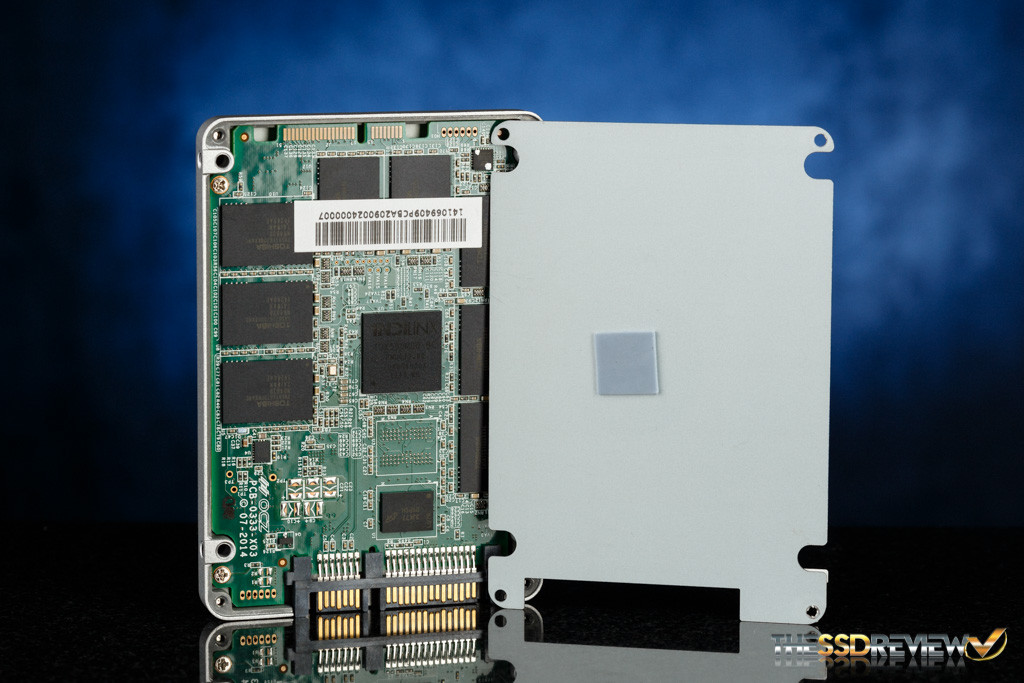A CLOSER LOOK INSIDE
Once disassembled we can see that there is a thermal pad stuck to the shell to aid in controller heat dissipation. This is now pretty much standard for most SSDs.
On the front side of the PCBs we can see that the design is very similar to that of the previous Vector 150. On the backside, however, an orange capacitor that sticks out and catches our eye. Located in the center is the Indilinx M00 controller. There are eight NAND packages on each side of the PCBs for a total of sixteen and there are also two DRAM chips on each PCB for cache.

 Below we have a close up of the capacitor used in the Power Failure Management Plus (PFM+) feature, which helps prevent ‘bricked drive syndrome’ that can occur during sudden power losses.
Below we have a close up of the capacitor used in the Power Failure Management Plus (PFM+) feature, which helps prevent ‘bricked drive syndrome’ that can occur during sudden power losses.
Next we can see they opted for Micron DRAM and of course Toshiba NAND. The Vector 180 is utilizing Toshiba’s A19 Toggle MLC NAND to provide the fastest performance possible. The 240GB model formats to 224GB usable capacity while the 480GB and 960GB models format to 447GB and 894GB respectively. The DRAM cache capacity varies per capacity with the 120GB and 240GB both containing 512MB while the 480GB and 960GB utilize 1GB, all of which is DDR3 1333MHz.
Finally we get to take a closer look at the last Indilinx Barefoot 3 M00 controller. Their Barefoot 3 controllers have proven to be quite the power house when it comes to real world workloads. While this is the last that we will see of this controller, we are very interested to see what is to come of its replacement down the road.
 The SSD Review The Worlds Dedicated SSD Education and Review Resource |
The SSD Review The Worlds Dedicated SSD Education and Review Resource | 

How long is it going to be before we forget-
“Friends DON’T let friends OCZ” ??????????
oh yeah, that’s so eighties…
PC Perspective threw an interesting monkey wrench at this device.
“With firmware 1.01 (current as of this writing), the Vector 180 halts every 20 seconds during sustained writes. TRIM operations also result in obvious stalls in subsequent host writes.”
Our final outlook of this SSD is determinate of all tests, the most demanding of which is PCMark 8. PCMark 8 puts the SSD through 18 hours of the most grueling activity, and well above consumer demands. The best part of independent testing is that there is always more than a single review to rely on. Obviously, we had a great respect for this SSD with the firmware on hand.
Why is the Mushkin Reactor in the consistency bandwidth charts with these drives when it is low to middle tier and the rest are top of the line ssds? Why not show the top of the line Mushkin Striker comparison instead?
I included the reactor to show a comparison to how an entry level SSD stands against the top tier SSDs. We also do not have a mushkin striker to compare.
Ok sounds good. Could you test an compare some of the new top brand ssds ? Mushkin Striker, Pny cs2111, Patriot Blaze, Corsair Neutron XT? I would like to see consistency bandwidth comparisons for these ssds. This way we can see how the new controllers stack up against each other. I hope you get some soon!
It is nice to see a company provide 3 different capacities to review at the same time.
The PFM is interesting but as stated it does not protect the data itself. You won’t have a bricked SSD but you’ll have corrupted data (and a full restore on your hands) if power is lost and the cache is holding write data. Supercaps are the only thing that will prevent that. Crucial showed that with the M500 series. Wish more companies jumped on that bandwagon.
How long will it take to forget-“Friends don’t let friends OCZ”